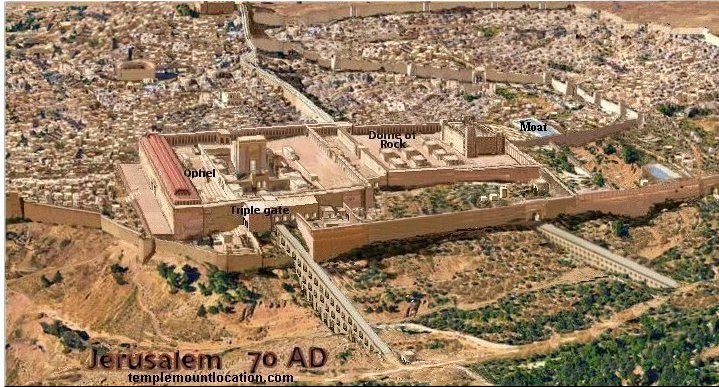The Temple Location
Tradition holds that the two previous temples of Solomon and Herod were situated over the Dome of the Rock. There have also been theories that the temple was just to the North or just to the South of the Dome of the Rock on the Temple Mount. Recently, with what seems to go back to the writings of Ernest L. Martin in 1994, there has been a lot of theories and beliefs that the temple may not have been on the Temple Mount, but rather to the South of the Temple Mount in the City of David. This page will look at the arguments for both sides with references for further personal reasearch. This page is focused more on the spacial aspect of the temple. For the history of the temple, go here.
I still have to do some more research on this but it presents, at the very least, some compelling thoughts. I also recognize I’m no authority on archaeology or history and so this page is a working collection of points from experts on both sides and is a work in progress....
What Do We Know?
The first place to start is simply to examine quotes from Biblical and historical first hand accounts. From the Bible we don't get much of a description of the details of the location, but we do know some facts about its location.
From the Bible
- In/On Mount Moriah (2 Chronicles 3:1 | 2 Chronicles 33:15)
- In the place that David had prepared in the threshingfloor of Ornan the Jebusite (2 Chronicles 3:1)
- In/At Jerusalem (2 Chronicles 3:1 | Ezra 1:2-5; 2:68; 3:8; 5:14-17; 6:5; 7:27 | Psalm 68:29 | Daniel 5:2-3 | 1 Kings 12:27 | 1 Chronicles 6:32 | 2 Chronicles 33:15)
- Yeshua travels at the triumphal entry from Bethphage and Bethany to the mount of Olives, entered into Jerusalem and into the temple. (Mark 11:1; 11-12)
- Mount of Olives opposite of the Temple (Mark 13:3)
- Solomon's house and the house of the LORD were encompassed by the walls of Jerusalem (1 Kings 3:1)
- Solomon's temple was 60 x 30 x 20 cubits (Length x Height x Breadth) (1 Kings 6:2)
- Solomon's porch was 20 x 10 cubits (Length [breadth of the temple] x Breadth) (1 Kings 6:3)
- King Jehoash is brought down from the house of the LORD by the way of the gate of the guard to the king’s house (2 Kings 11:19)
- The people sacrificed and burned incense still in the high places. Jotham the son of Uzziah built the higher gate of the house of the LORD. (2 Kings 15:35 | 2 Chronicles 27:3-4 | 1 Kings 3:2-4) This would seem to indicate there was a higher place than the temple that people were sacrificing at and so a gate was built at the temple leading to that higher place.
- The high gate of Benjamin was by the house of the LORD. (Jeremiah 20:2)
From scripture we can gather that the temple was opposite the Mount of Olives on Mount Moriah where the threshingfloor was within the walls of Jerusalem at the time of Solomon.
As described in 1 Kings 3:2-4, prior to the temple being built, “the people sacrificed in high places, because there was no house built unto the name of the LORD.” Then both 2 Kings 15:35 and 2 Chronicles 27:3-4 speak of Jotham, the son of Uzziah, building a higher gate of the house of the LORD because the people were still sacrificing and burning incense in the high places. This would seem to imply that the temple, which was on Mount Moriah, had points higher to it upon which people were sacrificing such that a gate was built on to that higher side.
From Favius Josephus
- Verse 1
- The temple built after Babylon was 60 cubits shorter than Solomon's temple. (Cyrus and Darius determined the measurements of the temple construction, which is why they didn't follow the original design.)
- Verse 3
- Herod took away the old foundations and laid new ones, erecting the temple on them. These foundations sank 20 cubits. (They resolved to raise them again in the days of Nero)
- The stones of the temple were 25 x 8 x 12 cubits (Length x Height x Breadth)
- The middle of the temple was visible to those that dwelt in the country for a great many furlongs.
- The entire temple was encompassed with very large cloisters (Covered, open air walk typically running along walls of buildings.)
- There was a large wall to both the cloisters
- The hill was a rocky ascent, that declined by degrees towards the east parts of the city, till it came to an elevated level. (Solomon encompassed with a wall upwards and round the top of it.)
- He also built a wall below, beginning at the bottom, which was encompassed by a deep valley; and at the south side he laid rocks together, and bound them one to another with lead, and included some of the inner parts, till it proceeded to a great height, and till both the largeness of the square edifice and its altitude were immense, and till the vastness of the stones in the front were plainly visible on the outside, yet so that the inward parts were fastened together with iron, and preserved the joints immovable for all future times.
- When this work [for the foundation] was done in this manner, and joined together as part of the hill itself to the very top of it, he wrought it all into one outward surface, and filled up the hollow places which were about the wall, and made it a level on the external upper surface, and a smooth level also.
- This hill was walled all round, and in compass four furlongs, [the distance of] each angle containing in length a furlong: but within this wall, and on the very top of all, there ran another wall of stone also, having, on the east quarter, a double cloister, of the same length with the wall; in the midst of which was the temple itself.
- This cloister looked to the gates of the temple
- Verse 4
- On the north side [of the temple] was built a citadel, whose walls were square, and strong, and of extraordinary firmness.
- This citadel was built by the kings of the Asamonean race, who were also high priests before Herod, and they called it the Tower, in which were reposited the vestments of the high priest. (They were kept there and after he died they were under the control of the Romans)
- Herod fortified the tower, in order to secure and guard the temple. To honor his friend and Roman ruler Antonius, he named it the Tower of Antonia.
- Verse 5
- In the western quarters of the enclosure of the temple there
were four gates:
- The first led to the king's palace and went to a passage over the intermediate valley
- Two led to the suburbs of the city
- the last led to the other city, where the road descended down into the valley by a great number of steps, and thence up again by the ascent for the city lay over against the temple in the manner of a theater, and was encompassed with a deep valley along the entire south quarter.
- To the South, the fourth front of the temple had gates in the middle and also had the royal cloisters, with three walkways that stretched from the East valley to the West valley. (Looking down from the battlements/cloister was very high from the valley below)
- This cloister had 162 pillars that stood in four rows with the fourth row interwoven into the wall. Each pillar was the diameter of three men joining hands around it. They were twenty-seven feet long (tall), with a double spiral at their base. These four rows of pillars created three walkways in the middle of this cloister, two the same size with a breadth of thirty feet, the length was a furlong, and the height fifty feet. The breadth of the middle walkway of the cloister was one and a half times those on either side, and the height was double. The roofs were adorned with deep sculptures in wood, representing many sorts of figures. The middle was much higher than the rest, and the wall of the front was adorned with beams, resting upon pillars, that were interwoven into it, and that front was all of polished stone.
- In the midst of this cloister was the second, to be gone up to by a few steps: this was encompassed by a stone wall for a partition, with an inscription, which forbade any foreigner to go in under pain of death. Now this inner enclosure had on its southern and northern quarters three gates [equally] distant one from another; but on the east quarter, towards the sun-rising, there was one large gate, through which such as were pure came in, together with their wives; but the temple further inward in that gate was not allowed to the women; but still more inward was there a third [court of the] temple, whereinto it was not lawful for any but the priests alone to enter. The temple itself was within this; and before that temple was the altar, upon which we offer our sacrifices and burnt-offerings to God. Into none of these three did king Herod enter, for he was forbidden, because he was not a priest. However, he took care of the cloisters and the outer enclosures, and these he built in eight years.
- In the western quarters of the enclosure of the temple there
were four gates:
- Verse 6
- The temple was built by the priests in a year and six months. The celebration of its rebuilding coincided with the king's inauguration and so the celebration was great.
- Verse 7
- There was a passage built for the king that led from Antonia to the inner temple, at its eastern gate. Over this he also erected a tower for himself so he could get into the temple to guard against any sedition made by the people against their kings.
From Aristeas
The Views
There are five views as generally represented in the image below. You can click on the various temples to jump to that section. (This depiction is not precise, it's meant to be a general view)
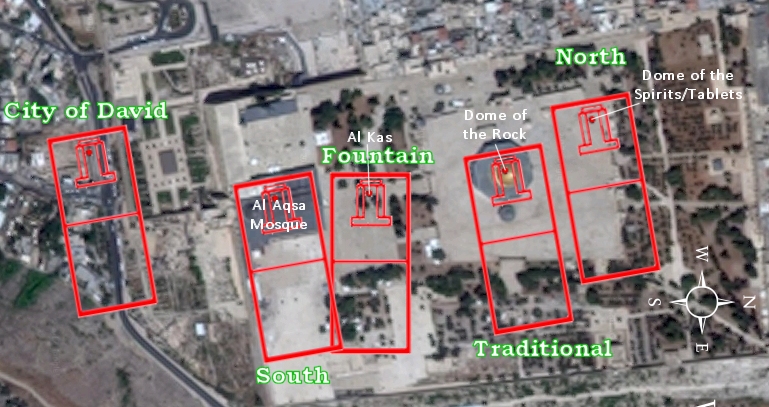
The Temple Mount
Modern Destruction By Richard Benkin, Ph.D. (May 2003) - In 1886, British explorer Captain Charles Wilson undertook the most comprehensive survey of Jerusalem in modern times, noting, “No one has ever questioned that the [Jewish] Temple formerly stood within the Haram-es-Sherif [Moslem name for the Temple Mount].”1 It would be difficult to think of a more absurd notion. To deny that reality denies the essence of both Jewish and Christian scripture. They both contain voluminous reference to the temples, from their construction to the events in the life of Jesus. In fact, Moslem and Arab history also confirms Warren’s declaration. Before 638 CE—a rather late date in the history of that region—there was no Islamic presence in Jerusalem. Its conqueror, the Umayyad Caliph, Umar, asked its Byzantine Patriarch, Sophronius, to show him the site of the Jewish Temples almost immediately upon entering the city. Sophronius did so and said, “Here is that appalling abomination.” Umar was indeed appalled—but not by the Temple itself. He was incensed at the accumulated garbage and debris, which he believed desecrated that Jewish holy site. He ordered the site cleansed immediately in a manner befitting its holy purpose. Soon thereafter, he commissioned The Dome of the Rock on the Mount, and his son had Al-Aqsa mosque built there as well. These edifices were not constructed to mark a Moslem holy site but to advertise Moslem hegemony over Jerusalem with its Jewish and Christian holy sites. more...
There are four beliefs of the placement of the temple on the Temple Mount area. The traditional location places the temple where the Dome of the Rock currently sits. There are also conjectures for a location to the North and to the South of the Dome of the Rock.
Traditional Location
The traditional location places the Holy of Holies on the rock over which the Dome of the Rock was built. It is believed to be the site where Abraham offered Isaac and the threshingfloor David purchased and built a temple to the Lord on.
Certain historical accounts say that this building was built by the Moslems to overlay the location of the original Jewish Temple(s) and most rabbis in Israel today associate the original Temple location with this site. Dr. Leen Ritmeyer has researched and written on the original 500 cubit square boundaries of the original Temple Mount site based on this assumption. Recent journal articles still support this view. (1) Former Jerusalem District archaeologist Dr. Dan Bahat vigorously defends the traditional location - drawing on his years of experience and study of the entire city and its history. - Templemount.org
Arguments For
Pending research...
Research Links For the theory:
-
Dr. Ritmeyer Interview: What is the Archeological Evidence on the Temple
Mount?
- Book: Jerusalem - The Temple Mount - The authoritative text of JERUSALEM: THE TEMPLE MOUNT contains priceless information and is richly documented with detailed maps, plans and stunningly evocative reconstructive illustrations. An artistic masterpiece in itself, this important addition to the scant literature on the Temple Mount will be equally appreciated by Jerusalem residents, tourists and armchair travellers.
- Book: The Quest: Revealing the Temple Mount in Jerusalem - No book is better suited to the study, understanding and development of the manmade plateau that is the focus of the world s interest the Temple Mount in Jerusalem. Ritmeyer's experience as architect of the Temple Mount Excavations following the Six-Day War, coupled with his exploration of parts of the mount now hardly accessible and his doctoral research into the problems of the Temple Mount make him singularly qualified for the task.
Arguments Against
Pending research...
Research Links Against the Theory:
Northern Location
Based on a number of topological and archaeological considerations, research by Dr. Asher Kaufman over the past two decades has resulted in serious consideration being given to a site 330 feet to the north of the Dome of the Rock. The Mt. Moriah bedrock outcrops within the Dome of Rock, as is well known. Although the bedrock elevation drops sharply to the south in the direction of the City of David, the level of the bedrock is just beneath the paving stones for over 100 meters to the North of the Dome of the Rock shrine. One particular level outcropping of this bedrock lies under a small Islamic shrine known as "The Dome of the Tablets" or "The Dome of the Spirits," to the Arabs. Both names suggest an association with the Jewish Temples. It is under this small, unimpressive canopy supported by pillars that Dr. Kaufman locates the Temple site. - Templemount.org
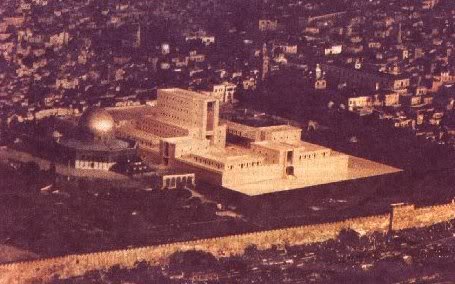
Arguments For
The Third Temple Entrance In Alignment With The East Gate - This author presents the information which places the Holy of Holies at the Dome of the Spirits/Dome of the Tablets and is lined up with the Golden Gate directly to the East.
The Dome of the Spirits
This small dome, also called the Dome of the Tablets, has attracted interest because of Asher Kaufman’s theory that it marks the place of the Holy of Holies in the Second Temple. The dome is located on the east-west line from the peak of the Mt. of Olives through the Golden Gate to the two domes of the Holy Sepulcher on the west. Upon the peak of Olivet, according to the Mishnah, the High Priest used to stand when he sacrificed the Red Heifer. During this ceremony, he would have had to look into the Holy of Holies and sprinkle the blood in its direction; the Temple should have lined up, then, with the peak. Kaufman adduced archaeological data to support the theory that the Temple was here, but it has not gained wide acceptance, partly because of the topography. We know from Warren’s investigations (1868) that a little to the north was a moat, extending St. Anne’s Valley. Herod filled it in, but it was probably there in Solomon’s time. Assuming the Second Temple was built where the First had been, the north side of Solomon’s Temple, if here, would have been on the slope, slightly below the peak and asymmetrically close to this moat. Without more archaeology, however, no one can be certain where the Temple was.
- Dome of the Spirit - Jerusalem - This little dome, about 10 feet in diameter, has been called the “Dome of the Spirit” and the “Dome of the Tablets” for many centuries. Some archeologists believe it was the actual site of the Holy of Holies, for three reasons:
- (1) it is in perfect alignment with the ancient East Gate
- (2) it is the only place on the Temple Mount where the floor is solid bedrock, just like the threshing floor that King David purchased as the site for the altar, II Sam. 24:24
- (3) the dome stands 330 feet north of the Dome of the Rock, allowing enough room to rebuild the Jewish temple on this site if one would “leave out the court which is outside the Temple” as God instructed John, Rev. 11:2.
Dome Of the Spirits, or Tablets
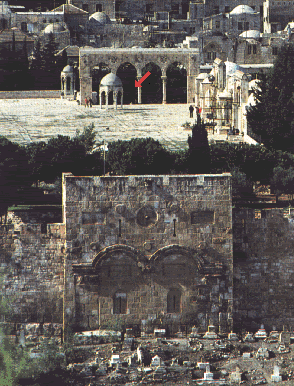
With the temple placed such that the Holy of Holies is located on the Dome of the Spirits, this is what it would look like. Put together with Revelation 11:1-2 we have a location that fits with Bible prophecy such that if the outer court is not built for this third temple, it fits right next to the Dome of the Rock and the Holy of Holies lines up perfectly with the Golden Gate, or East gate.
Revelation 11:1-2
And there was given me a reed like unto a rod: and the angel stood, saying, Rise, and measure the temple of God, and the altar, and them that worship therein. But the court which is without the temple leave out, and measure it not; for it is given unto the Gentiles: and the holy city shall they tread under foot forty and two months.
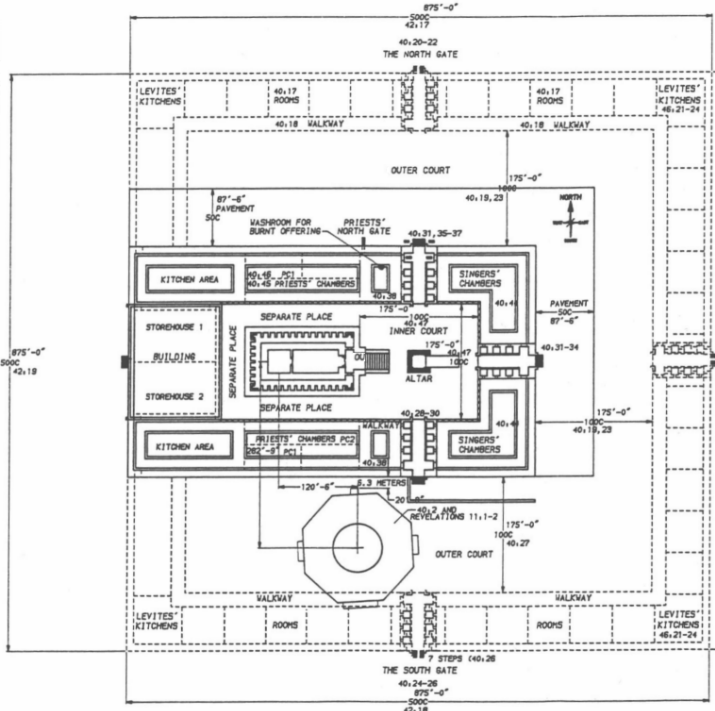
Research Links For the theory:
Arguments Against
Pending research...
Research Links Against the theory:
Fountain Location
This view puts the temple over the Al Kas Fountain between the Dome of the Rock and the Al Aqsa Mosque.
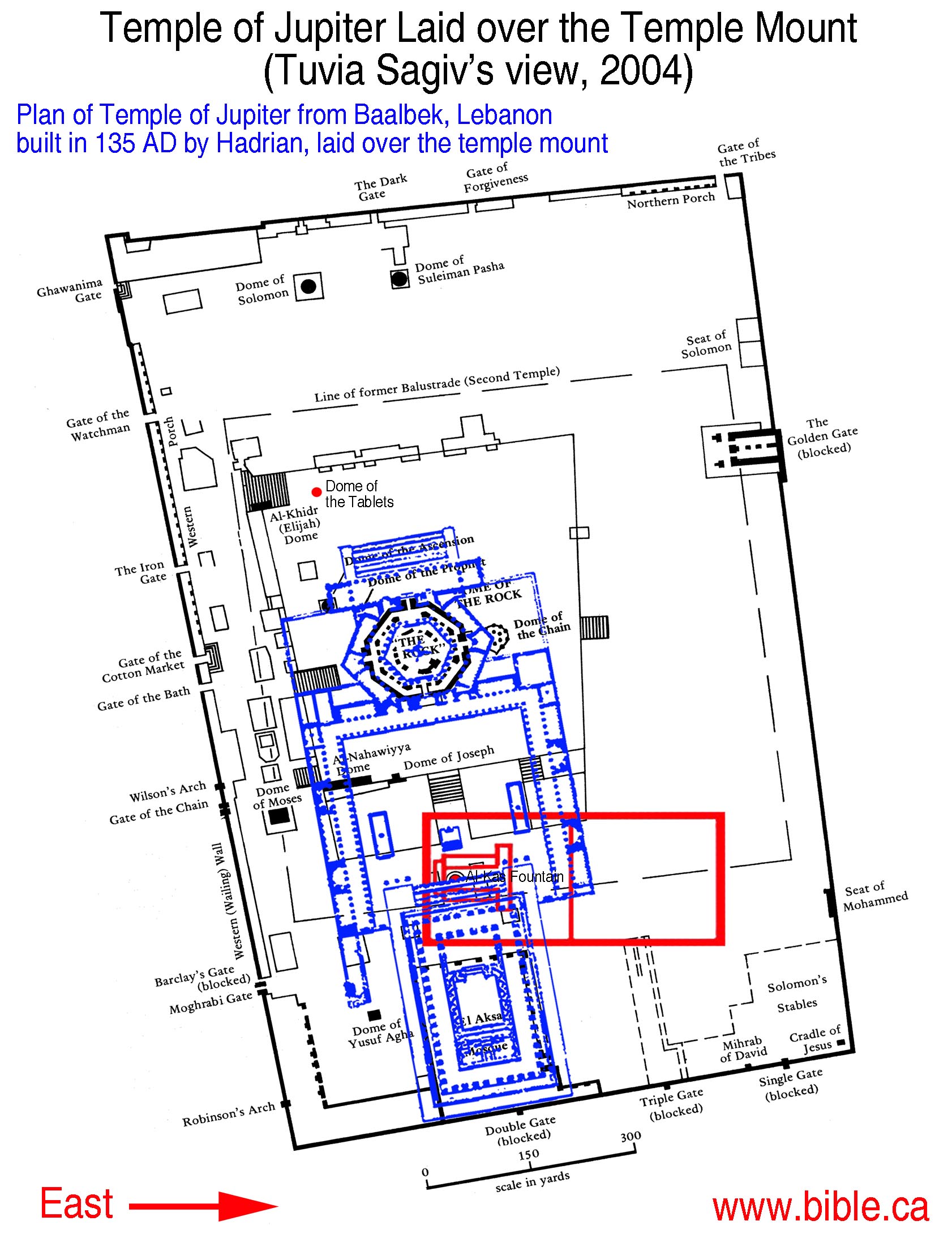
Arguments For
Pending research...
Research Links For the Theory:
- East orientation of Jewish temples and altars
- Temple of Solomon was located directly over the Al-Kas fountain
- The Temple in Jerusalem over the threshing floor which is presently under the Al Kas fountain
Arguments against
Pending research...
Research Links Against the Theory:
Southern Location
This view has been put forth by several people, including Tuvia Sagiv and Norma Robertson. It places the temple to the South of the Dome of the Rock in place of the Al Aqsa Mosque.
Arguments For
Secrets of the Temple Mount by Tuvia
Sagiv
Locating Solomon’s Temple by Norma Robertson
Research Links For the Theory:
- Locating Solomon's Temple - This page shows a progression through time of the temple under this theory with pictures depicting how it looked.
- Southern Location: Secrets of the Temple Mount in Jerusalem - Tuvia Sagiv YouTube
- What If This Isn't the Western Wall? by Gershom Gorenberg
Arguments against
Pending research...
Research Links Against the Theory:
Temple in the City of David
The Temples That Jerusalem Forgot by Ernest L. Martin was released in 1994 and presented an alternative view based on interpretations of the writings of Flavius Josephus and others as well as archaeological evidence that the first and second temples were not located on the traditionally accepted location of the temple mount.
I heard about this initially from a Koinonia House Podcast (K-Rations) with Chuck Missler interviewing Robert Cornuke, author of another book on the subject released April 30, 2014 TEMPLE: Amazing New Discoveries That Change Everything About the Location of Solomon’s Temple (which you can also get on Kindle). There’s also a YouTube Video. In it they referenced Ken Klein’s documentary Jerusalem and the Lost Temple of Jews, which you can watch free now with Amazon Prime.
Honestly I find the subject fascinating if not somewhat overwhelming not having the greatest grasp of history and archaeology, but given the potential impact on the future state of the prophetic rebuilding of the temple in Jerusalem, I feel it’s important to look into it.
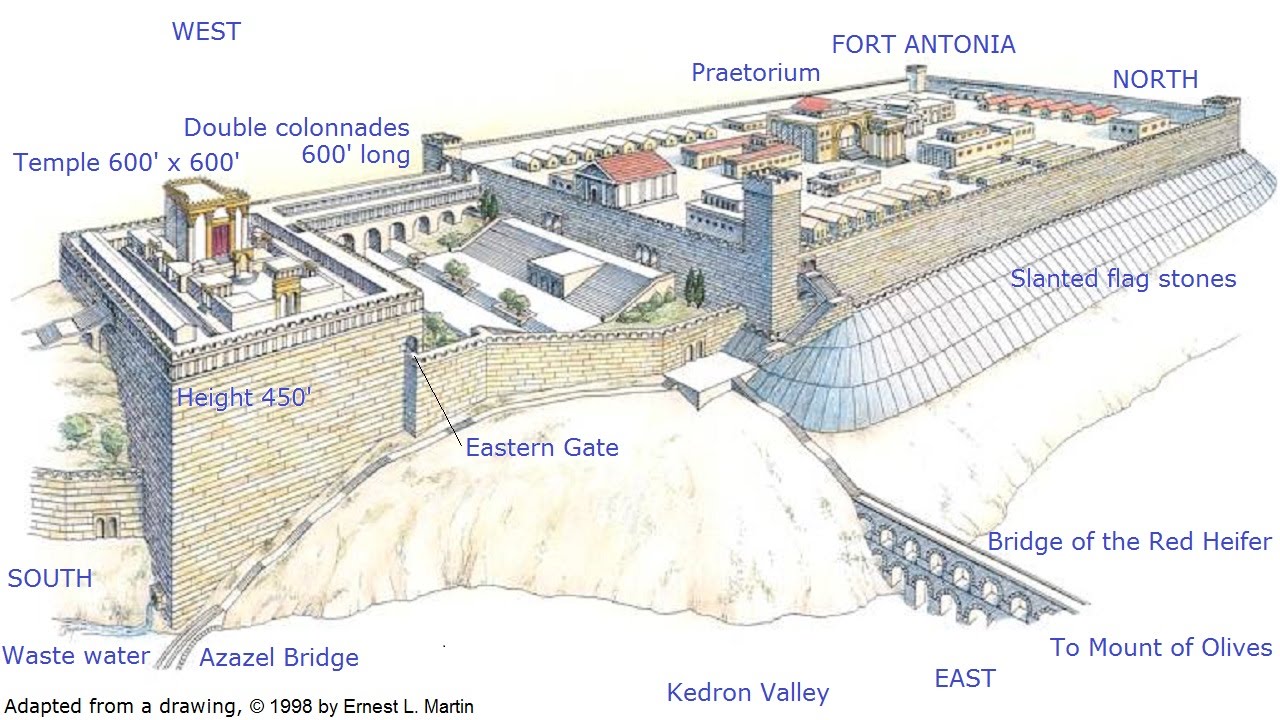
Arguments For
“It (Jerusalem) is now demolished to the very foundations, and hath nothing left but that monument of it preserved, I mean the camp of those (Romans) that hath destroyed it, which still dwells upon its ruins.” | Eleazer Ben Jair (Commander at Masada)
“Now as to the Tower of Antonia, it might seem to be composed of several cities. For if we go up to this Tower of Antonia, we gain the city since we shall then be upon the top of the hill.” | Josephus
“Now as to the tower of Antonia, it was situated at the corner of two cloisters (colonnades) of the court of the temple; of that on the west, and that on the north.” | Josephus
Acts 21:32
At once he (the commander) took along some soldiers and centurians and ran down to them.
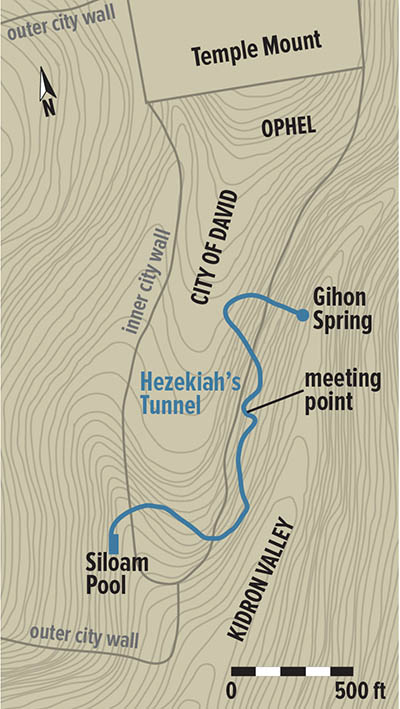
The Gihon Spring
Gihon means "Gusher" and it is a siphon spring that could pump water 40 stories, 400 feet from the bottom of the Gihon up to the City of David.
The Pool of Siloam
The area is an acre in size. The archaeologist who found it said, "It's the world's largest mikvah." This is fitting for the large number of people who would have to ritually bathe to go to the temple. Furthermore, where this only natural source of water in Jerusalem is, is about 1/3 of a mile from the Temple Mount. The temple would have to be close to the mikvah to prevent becoming unclean on the way to the temple. They also found the original stairs from the Herodian period going from the Pool of Siloam up to the city of David.
Hezekiah’s Tunnel
Hezekiah’s Tunnel, part of Jerusalem’s water system, is located under the City of David. It connects the Gihon Spring—Jerusalem’s fresh water supply—with the Siloam Pool. According to 2 Chronicles 32:2–4 and 2 Kings 20:20, this tunnel was dug during the reign of King Hezekiah of Judah to prepare Jerusalem for the imminent attack of the Assyrian king, Sennacherib. In the Bible, Hezekiah redirected the water through old and newly dug Jerusalem tunnels.
Research Links For the Theory:
- The Temple
- Film: Jerusalem and the Lost Temple of Jews (Watch free now with Amazon Prime) - This compelling video calls into question the common beliefs of the location of the original temples being on the temple mount. Spurred by the studies and book, The Temples That Jerusalem Forgot by Ernest L. Martin, Ken Klein walks through the key evidence from the historical writings of Flavius Josephus and others while actually walking through and filming in Jerusalem.
- Book: TEMPLE: Amazing New Discoveries That Change Everything About the Location of Solomon’s Temple - Can you imagine the upheaval in political and religious thinking if the Temple Mount in Jerusalem is not the site of Solomon’s and Herod’s temples? And what if the stones of the Wailing Wall are not what tradition says? In this highly-researched, exciting book, the author proposes from current archaeological excavations and Scriptural corroboration that the true temple location is not where tradition teaches. This is must reading for anyone who wants to fit together the pieces of biblical records, current geo-polotics, and prophecy.
- The Coming Temple! Where the Real Jewish Temple Stood in David's City YouTube - Toward the end of the video, they move to some speculative theories about the abomination of desolation that I don't hold to, but for the most part it’s a good video with lots of good information. Filmed in the Old City of Jerusalem, this ground-breaking documentary investigates the research of renowned Biblical archaeologists, Bob Cornuke, David Seilaff and Earnest L. Martin who claim that Solomon and Herod’s Temples never stood on the Haram al Sharif, also known as the Temple Mount. If they are right, then there is nothing to stop the Jewish people building their long awaited for Third Jewish Temple in the actual site where the Temples once stood. But is tradition too strong?
- The Temple | Bob Cornuke YouTube - Can you imagine the upheaval in political and religious thinking if the Temple Mount in Jerusalem is not the site of Solomon's and Herod's temples? And what if the stones of the Wailing Wall are not what tradition says? In this highly-researched, exciting book, the author proposes from current archaeological excavations and Scriptural corroboration that the true temple location is not where tradition teaches.
Arguments Against
1 Kings 8:1,6
Then Solomon assembled the elders of Israel, and all the heads of the tribes, the chief of the fathers of the children of Israel, unto king Solomon in Jerusalem, that they might bring up the ark of the covenant of the LORD out of the city of David, which is Zion. … And the priests brought in the ark of the covenant of the LORD unto his place, into the oracle of the house, to the most holy place, even under the wings of the cherubims.
From this passage, it would seem that the City of David was below the temple.
Research Links Against the Theory:
“Be not overcome
of evil, but overcome evil with good.” Romans 12:21 In accordance with Title 17 U.S.C. Section 107, any copyrighted work herein is archived under fair use without profit or payment to those who have expressed a prior interest in reviewing the included information for personal use, non-profit research and educational purposes only. Ref.
Watchman Bible Study | 2005 - 2024
